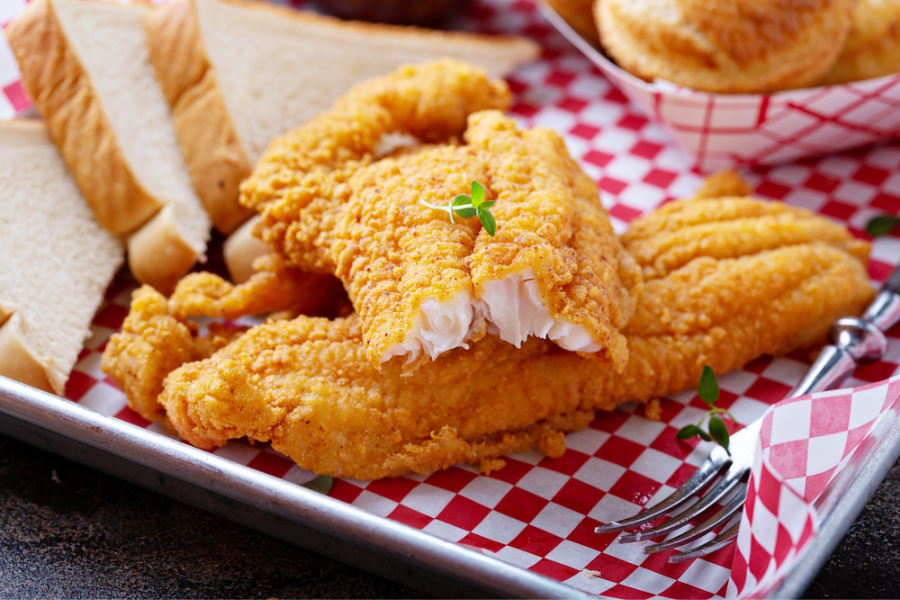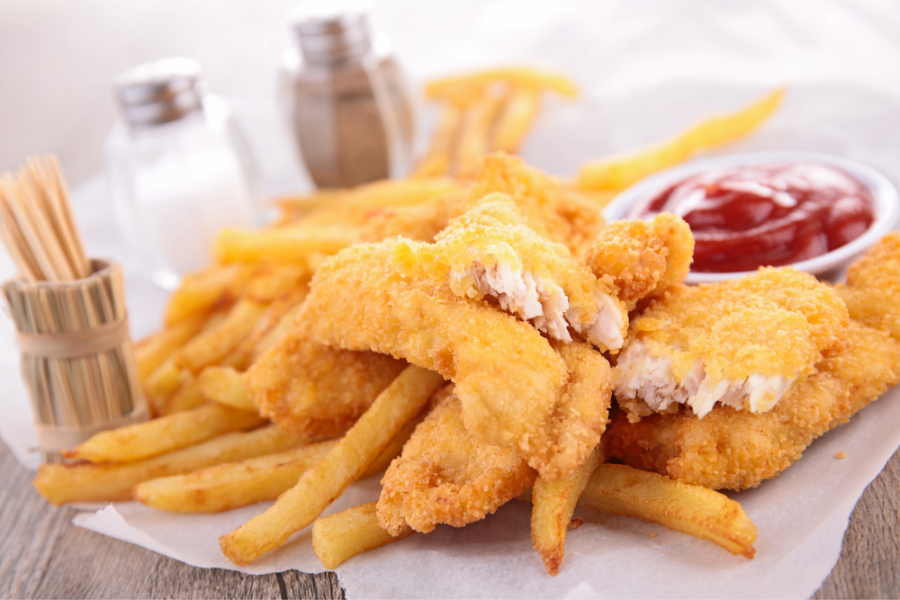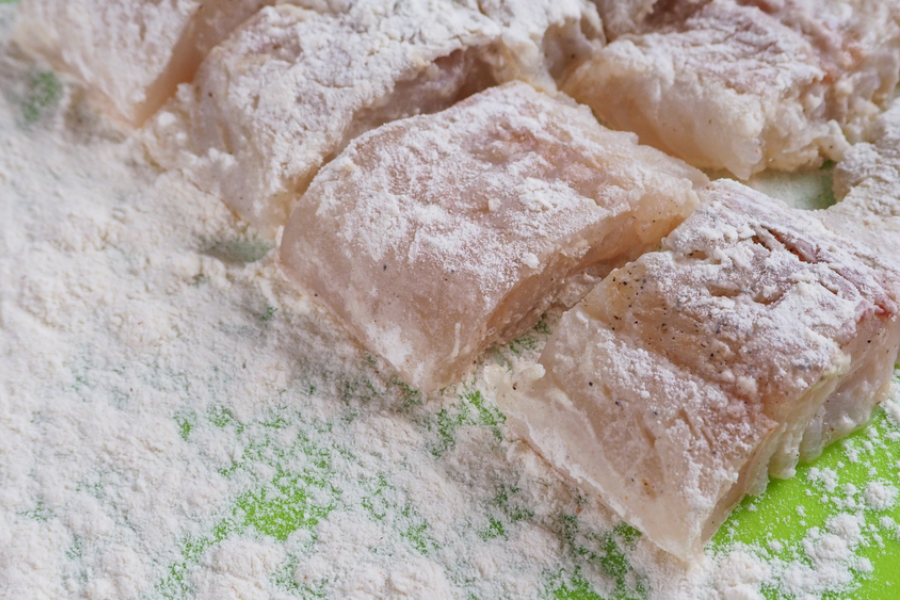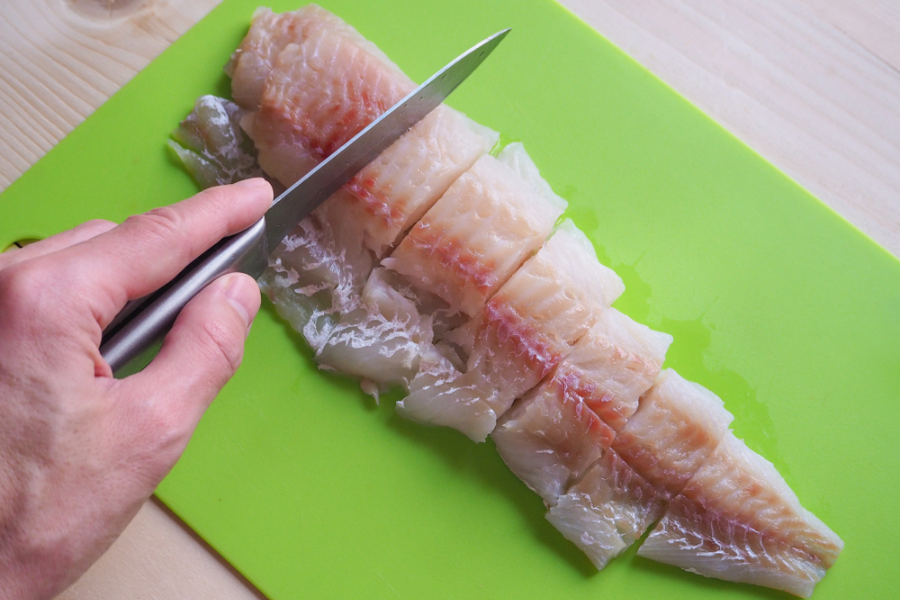Introduction
We all want the best for our dogs, right? Have you ever found yourself enjoying a plate of delicious fried catfish and wondered, “Can Dogs Eat Fried Catfish?” This question is not just about the treat itself but touches on broader topics like nutrition, pet health, and dietary restrictions.
In this article, we put a dog’s diet on top priority. Now, we’ve heard chatter about dogs and fish, especially fried catfish. There are lots of mixed messages out there. So, we’re going to clear things up. We’ll explore the nutritional value of catfish, how frying affects its suitability for dogs, and the potential health benefits and risks. Plus, we’ll dig into any risks of feeding them fried catfish. So, let’s get to the bottom of it—no more guessing games!

What’s in Fried Catfish?
We’re talking about what’s inside fried catfish. Why? Because it’s important to know what we’re giving our furry friends. Let’s dive in.
Breaking Down Catfish Nutrients
Catfish is known for its lean protein content; it’s also a source of various vitamins and minerals, including B vitamins. Additionally, catfish contains healthy fats, notably omega-3 fatty acids, known for their anti-inflammatory properties and benefits to heart health.
Fried vs Raw Catfish
However, the frying process changes the nutritional profile of catfish. Now, what happens when we fry the catfish? The protein stays about the same, but some vitamins and good fats can get lost in the heat. Moreover, frying can reduce water-soluble vitamins, like some B vitamins, due to the high temperatures involved.
The batter used in frying can also add carbohydrates and potentially gluten, which might not be suitable for all diets. Moreover, any seasonings added to the batter or the fish can introduce additional elements, like sodium, which might be a consideration for those monitoring their salt intake.
Potential Benefits of Catfish for Dogs
Let’s chat about how catfish can be good for your dog. Just remember, we’re talking about catfish prepared the right way – not fried!
Good Stuff in Catfish for Dogs
Catfish is packed with protein, which dogs need to grow and stay strong. It’s like the building block for their body!
That’s not all – catfish also has Omega-3 and Omega-6, which are types of fats. They can make your dog’s skin and coat look great and keep their brain sharp. Plus, they help dogs fight off sickness.
And let’s not forget about vitamins and minerals. Catfish has lots of them, like Vitamin B12, Vitamin D, iron, and magnesium. They’re like little helpers that keep your dog’s body running smoothly.

How Catfish Can Make Dogs Healthier?
What you feed your dog really matters. If you give your dog catfish, you might see some neat changes. Their skin could look better, and their coat might get shinier. Plus, they could be better at fighting off sickness. All this good stuff comes from the protein, vitamins, and minerals in catfish.
Does the Good Outweigh the Bad?
Catfish has lots of good stuff for dogs, but it’s important not to go overboard. Any time you give your dog something new to eat, start slow and watch closely to see how they react. Even though catfish is healthy, it doesn’t mean you should only feed your dog catfish. Dogs need a mix of different foods to stay healthy, like other proteins, veggies, and carbs.
Remember, all dogs are different. What works for one might not work for another. Always think about what’s best for your dog. If you’re not sure, ask your vet before you start giving your dog catfish.
The Risks of Fried Foods for Dogs
We all love our furry friends, and fried foods, like fried catfish, aren’t the best for them. Here’s why:
The Problem with Fried Foods
Fried foods are packed with fat. Too much fat can make dogs overweight, and that’s bad news. Overweight dogs can develop serious health issues like diabetes, heart problems, and joint pain. Also, high-fat foods can cause pancreatitis in dogs, which is a painful belly problem that can make them very sick.

The Risks of Fried Catfish
Fried catfish can be especially risky. First, there’s the chance that your dog might swallow a fish bone. This can hurt their insides or even make them choke. Second, the high fat in fried catfish can upset their belly, cause throwing up, diarrhea, or even pancreatitis.
Long-Term Risks of Fried Foods
Feeding your dog fried foods regularly isn’t a good idea. Over time, it can lead to constant health problems like obesity and pancreatitis. Plus, a dog that’s always sick may not live as long. Keep your dog’s meals healthy and balanced, and save fried treats for special occasions only.
Is It Safe to Regularly Include Catfish in a Dog’s Diet?
We’ve looked into whether it’s safe to feed your dog catfish regularly. As it turns out, your dog may benefit from the huge amount of protein and healthy fats found in catfish. Keeping a steady balance is key. There may be issues if there is an excess of something.
Not all dogs can eat fish, and some can’t even eat catfish. Itching, indigestion, and ear infections are some of the things to watch out for. Allergies to catfish might manifest in these ways in your dog. Hurry to the vet’s office if you see any of these symptoms.
Too much catfish in your dog’s diet might cause further problems. One of two things may happen: your dog could put on weight or choke on a bone. Take caution, since these are major issues.
So, what’s the final word from the experts? Well, fish is perfectly OK, according to veterinarians and pet nutritionists. Be sure it’s cooked through and has no visible skin or bones. And remember, moderation is key.
Consult your veterinarian before making any changes to your dog’s food. Dogs are unique individuals, just as humans. Advice on what’s best for your pet may be found from your vet.

Making Catfish Tasty and Healthy for Dogs
Let’s talk about the best ways to cook catfish for your furry friends. The way we cook can change a lot about the food, from how good it is for your dog to how easy it is to eat.
Cooking Catfish for Dogs: Steaming vs Frying and Bone Check
You could fry or steam catfish, but we think steaming is better for dogs. Frying can make the fish too fatty, and that’s not good for your pup. And remember, before you serve the fish, check that there are no bones. Bones can be bad news for dogs if they swallow them.
Easy Steps to Cook Catfish for Dogs
Now, let’s go through how to cook catfish for your dogs:
First, wash the catfish with water.
Next, take out all the bones.
Put the fish in a steamer.
Steam it until it’s cooked. This should take 10-15 minutes.
Let it cool down before you give it to your dog.
And here are some tips when you start feeding catfish to your dog:
Watch your dog when they’re eating. This can help avoid choking.
Start with small bits of fish to see if your dog likes it.
Keep an eye on your dog for any signs of allergies or stomach problems.
Remember, every dog is unique. What’s good for one dog might not be good for another. It’s always a good idea to talk to your vet before changing what your dog eats.
Portion Control and Frequency: How Much and How Often?
When it comes to feeding your dog catfish, it’s crucial to understand the importance of portion control. Managing the quantity and frequency of catfish in your dog’s diet is essential for maintaining their overall health and wellness. It’s all about balance and moderation.
Importance of Portion Control
Feeding your dog catfish in moderation is key. Overfeeding can lead to obesity and other health complications. Therefore, it’s vital to avoid the mindset of ‘more is better‘ and instead focus on controlled, balanced portions.
Recommendations for Frequency
So, how often should your dog be eating catfish? There isn’t a one-size-fits-all answer to this, as it depends on various factors such as your dog’s size, breed, age, and health. However, we suggest incorporating catfish into your dog’s diet 1-2 times per week as a general guideline. This frequency should provide the benefits of the nutrients found in catfish without overloading your dog’s system.

Gradual Introduction and Observation
When introducing catfish into your dog’s diet, it’s best to do so gradually. Start with small portions and observe your dog for any adverse reactions. Signs to look out for include changes in their vomiting, stool,loss of appetite, or unusual behavior. If any of these occur, it’s best to consult with your vet immediately. Remember, every dog is unique, and what works for one might not work for another. Therefore, always monitor your dog’s reaction when introducing new foods.
Conclusion
During our exploration of pet food, we have uncovered intriguing insights about catfish. This fish is very nutritious, including abundant amounts of protein and omega-3 fatty acids, which are crucial for promoting your dog’s optimal health and overall vitality. Nevertheless, when it comes to fried meals, the situation becomes more complex.
Consuming in fried foods might result in weight gain and health problems for dogs. Therefore, steaming is notable for preserving the valuable nutrients while excluding the undesirable components. After all, your dog’s response serves as the most accurate indicator of whether a certain dish is successful or not.
